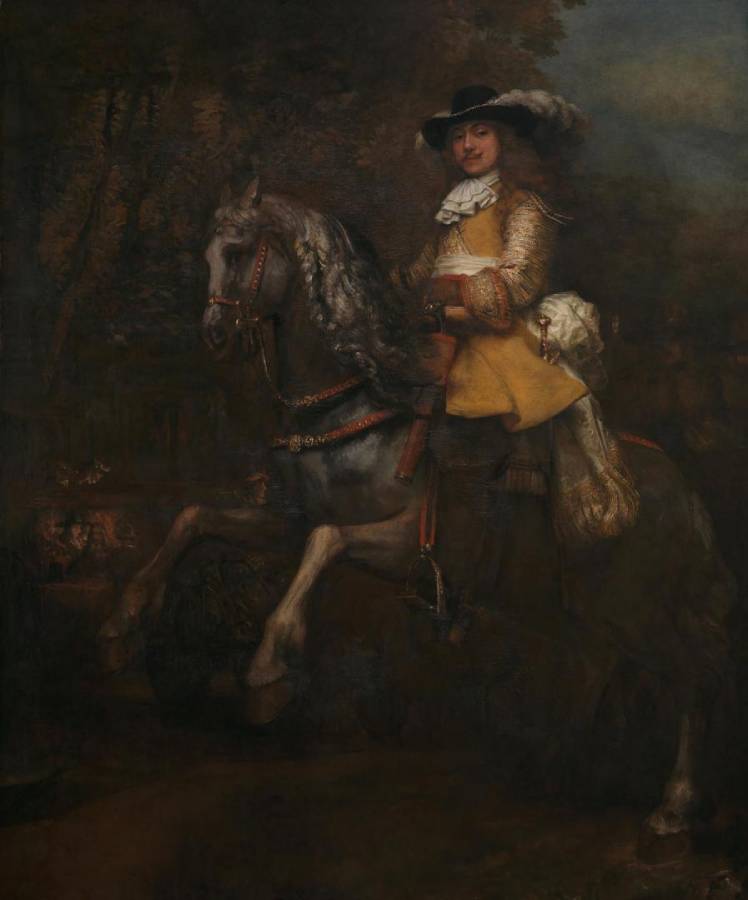Rembrandt (1606-1669)
Portrait of Frederick Rihel on Horseback
c.1663
Oil on canvas, 294.5 x 241 cm
National Gallery, London
This life-size portrait of a man on a rearing horse is an extremely unusual painting. It is one of the largest ever made by Rembrandt (only two of his surviving canvases are bigger) and one of only two life-size equestrian portraits of ordinary citizens in the history of Dutch art. Apart from a much smaller picture known as The Polish Rider (Frick Collection, New York), it is also one of only two equestrian paintings made by the artist.
Rembrandt’s lack of experience in depicting horses may explain the rather stiff, sketchy figure of the animal here. He has drawn our attention instead to the horseman, emphasised by his bright yellow jerkin, fancy gloves, shimmering sleeves and plumed hat. Much of the rest of the painting is, like the horse, only sketched in, often quite broadly using bold, black outlines. This makes the rather gloomy background difficult to interpret. The rider seems either to be leading or taking part in a procession which winds around a stretch of water behind him. It is possible to make out the prow or stern of a boat in the left foreground. Also on the left is the roughly sketched facade of a building; it may be the Heiligewegspoort, one of the gates to the city of Amsterdam (now demolished). In front of this is a coach with a bright red and yellow interior carrying three passengers. There’s a groom on the running board, and the heads of the driver and two coachmen at the rear are also just visible. The coach is part of the procession, as are the two (or possibly three) riders on horseback in the right background.
Although he is not named on the painting, most experts agree that this is a portrait of Frederik Rihel, a prosperous businessman who was born in Strasbourg in 1621 and moved to Amsterdam in 1642. He was a member of the city’s civic guard and was eventually promoted to the prestigious post of ensign, or standard bearer. This identification is based on the inventory of Rihel’s property drawn up after his death in 1681, which included a ‘portrait of the deceased on horseback by Rembrandt’. Since this is Rembrandt’s only recorded equestrian portrait (The Polish Rider probably isn’t a portrait) and Rihel was known to be a keen horseman, the evidence is convincing. The horse’s elaborate harness and most of the rider’s clothing also seem to be listed in the inventory (for example: ‘a variety of sashes some with silver and gold fringes and with matching gloves and a leather jerkin embroidered with gold thread’). Most likely, Rihel commissioned the portrait, which is dated 1663, to commemorate his membership of the Amsterdam Guard of Honour which accompanied the entry of Prince William of Orange into Amsterdam in 1660.
In 2008, an X-ray scan of the painting revealed another, apparently unrelated, composition beneath the portrait now visible: a full-length figure of a man, turned at 90 degrees to the canvas. This suggests an unwanted or unfinished canvas was reused, which wasn’t uncommon in Rembrandt’s studio, although this is by far the largest example known, and appears to be the only instance in which Rembrandt adopted this practice for a commissioned portrait. (NG)
See also:
• Rihel, Frederick (1621-1681)
